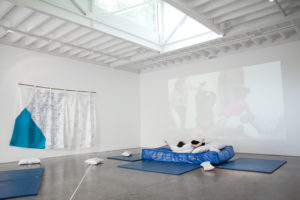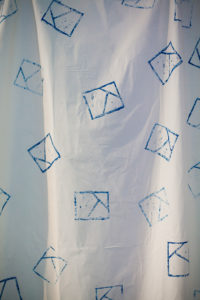Rough Play
By Anna Gritz, Curator, South London Gallery.
Rough Play is a work by Laura Eldret that originated from a series of workshops on play fighting hosted with children between the age of five and sixteen in the spring of 2013 at the South London Gallery as part of the SLG local initiative and in close conversation with the education team at the South London Gallery.
Following her interest in exploring divergent aspects of how groups of people gather she set about exploring play fighting through workshops. The use of workshop format (1) is a strategy that Eldret employs as ‘research in action’ (2), however that on this account could also be considered as a form of testing ground or raw rehearsal. Opposed to finalizing all details of a project ahead of time the workshop format allows for the participants to feed back and to influence the course of a piece. In advance of the workshops Eldret devised a set of basic elements and rules that outlined the larger objective of the project and that were developed further in response to the results of the individual play fighting workshops. Eldret calls this set of conditions, interventions, employing them to create an environment that is steered by artistic concerns in addition to the larger pedagogical framework of play fighting within play working and education.
The workshops culminated in a session that was staged for camera and whose footage was later cut and edited to devise the film for the projection presented in the installation of Rough Play. The final installation and the workshops scenario are almost identical in set up, the only difference being the large projection of the finished film on the back wall of the space. The basic components of the project consisted of a set of cushions that functioned at once as armory, shields, and pillows, a piece of wall-mounted fabric, which doubles a banner for the project, two large crash mats and a couple of smaller mats. All elements were delineated by a taped outline on the floor dividing the space into three different areas. Each one of the zones prescribed with its own set of rules and behavioral conventions. For example there is no play fighting in the time-out zone, it is a dedicated place for rest and withdrawal, a personal break and breathing space, and respectively the crash matts and the cushion zones are places of action in which the children are allowed to fight each other within the previously agreed parameters of the game. The shape that describes the three zones reappears throughout the project and also adorns both the cushions and the wall-mounted fabric and functions there as embellishment, logo, blue print, instruction drawing and herald of the project(3).
More than just a place for childhood development and play, Eldret’s set up invokes a ceremonial space. Similar to tracing boards used in ceremonies of freemasonry the shape employed in the banner and on the floor occupies simultaneously a symbolic and practical function in the ritual (4). It symbolizes the metaphysical change as well as instructing the participants how to partake in the procedure. The ritual sets in motion a form of transformation and although the term transformation may appear heavy-handed in relation to the practice of play fighting, nevertheless it does feel applicable if one considers play as a means of accommodating and assimilating reality. And by observing the work it becomes quickly clear how even assimilated fight and conflict resolution can be a transformative experience in the development of a child.
I am here mainly referring to the theory of play developed by Jean Piaget, especially in regards to his thoughts on rules and their formation through interaction between children and adults as a form of cooperative negotiation(5). The progress of formulating rules, even if just to break them, or to reformulate them at a later point, is essential in Rough Play. Together with the participating children and play workers a scenario is created and each change of the frame/ rule work has a vital influence on the shape and outcome of the resulting artwork. Rulemaking and decision-making are employed as a collaborative process that impacts on both the pedagogy and the artistic strategy.
Another work that was heavily influenced by Piaget’s theories is Ericka Beckman’s film The Broken Rule, from 1979, marking the second part of her Piaget Trilogy. The experimental film delivers an accomplished look at play and games and their relationship to gender dynamics and the work place. Beckman describes the film as her reaction to the American education system. Learning blocks are portrayed as relay races conducted by male contesters while the girls are bound to function as scores and cheerleaders on the margins of the play field(6). Mike Kelley plays the protagonist who continuously refuses to understand the rules of the relay race, his clumsy attempts to boycott the game and to render himself useless is portrayed as a battle against a system that just like life outside the game functions according to agreed upon rules, levels, scores and rewards.
Although unscripted and not employing actors Eldret’s work can be seen as resolving the contradiction between game and reality in a similar manner. The staged fight scenario is presented as a way for the children to explore themselves and the consequences their actions can have in a save and controlled scenario. They can get a sense of their own strength, coordination, and force. Nevertheless the separation between play and fight seems permeable. The film does not reference the workshoped nature of the project; instead it presents the playfighting scenario through long paning shots over a landscape of fighting children. An epic battle scene is presented that appears choreographed despite its chaotic nature. Guided by a couple of lead figures who direct the eye of the viewer and reveal underlying micro narratives in the turmoil of flying limps, cushions, and aimless bodies, the film diffuses the boundaries between reality and imagination, fiction and documentation, acting and play.
The staged scenario of the project is enhanced by the presence of the camera in the workshops, and observers, and props provoke a self-conscious if not subconsciously directed behavior in the children. Nevertheless in the film it becomes apparent that in the heat of the action the artificiality of the game fades away and that the children at times find themselves in actual fight situations, responding instinctively and no longer able to tell the difference between play and reality. These fractions and slippages create a strong tension between the supposedly manmade nature of the game and the reality of the life around it– making it clear that “one person’s work is another person’s play”(7).
_________________________________________
1. The strategy of developing an artwork through workshops with colleagues and/or untrained personnel is a method that was introduced to the art world context by dancer and choreographer Anna Halprin. In 1955, she founded the progressive and highly experimental San Francisco Dancers Workshop, which allowed for public participation and exploration of new types of movement. Her strategy to approach a new work through a series of workshop, coauthoring with colleagues and untrained participants was something that would find its way into the practice of her students such as Robert Morris and Simone Forti, but also playing a significant role in the work of Mike Kelley, Ericka Beckman, and continuing to be practiced by a younger generation of artists such as Edward Thomasson, Lucy Beech and Alice Theobald and others.
2. Laura Eldret in conversation with the author October, 2013
3. Laura Eldret in conversation with the author October, 2013
4. Rees, Julian: Tracing Boards of Three Degrees in Craft Freemasonry Explained, Addlestone 2009.
5. Piaget, Jean: The Moral Judgment of the Child. New York, 1932.
6. Ericka Beckmann, 1979 (http://www.erickabeckman.com/The_Broken_Rule.html)
7. Ericka Beckman, 1979 (http://www.erickabeckman.com/The_Broken_Rule.html)


